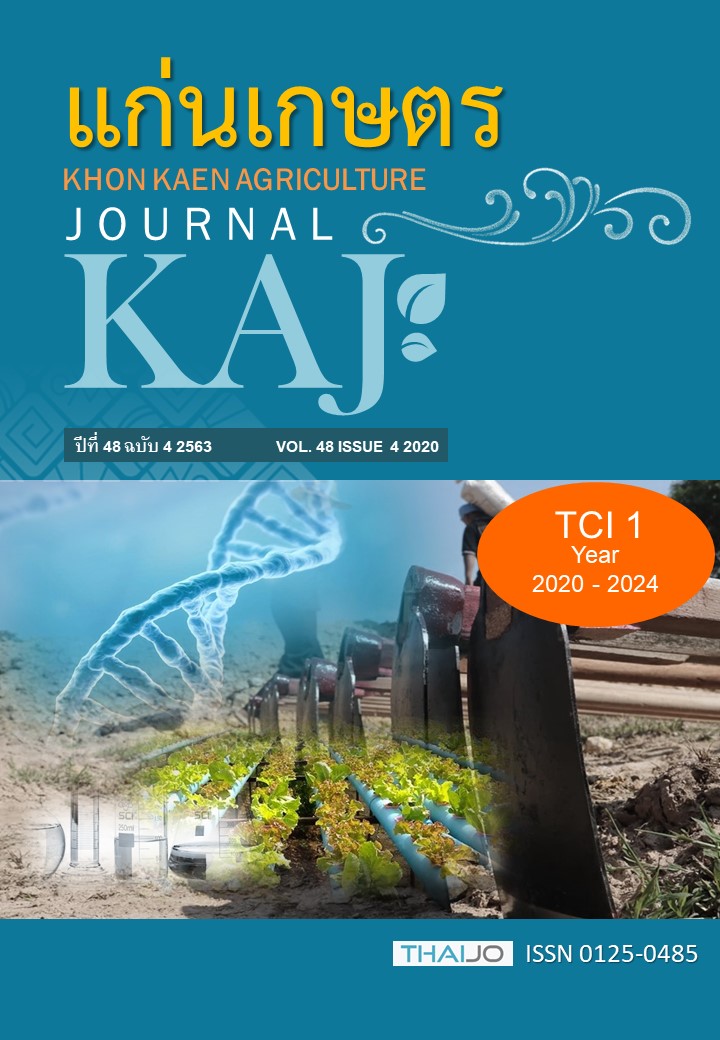ความแตกต่างของสารทุติยภูมิของเชื้อรา Aspergillus flavus กลุ่มที่สร้างและไม่สร้างสารพิษอะฟลาทอกซิน
Main Article Content
บทคัดย่อ
การตรวจสอบสารทุติยภูมิโดยใช้ gas chromatography mass spectrometry (GCMS) เป็นเครื่องมือสำคัญที่ใช้ตรวจสอบชนิดของสารทุติยภูมิที่สิ่งมีชีวิตสร้างขึ้น จึงได้นำมาเปรียบเทียบความแตกต่างในการสร้างสารทุติยภูมิของเชื้อรา A. flavus ที่สร้างและไม่สร้างสารอะฟลาทอกซิน จากการคัดเลือกเชื้อรา Aspergillus flavus จำนวน 15 ไอโซเลทที่แยกได้จากเมล็ดข้าวโพดในพื้นที่เพาะปลูกจังหวัดนครปฐมและกาญจนบุรี โดยใช้ลักษณะทางสัณฐานวิทยาของเชื้อรา และวิเคราะห์ลำดับนิวคลีโอไทด์บริเวณ ITS ระบุได้ว่าเป็นเชื้อรา A. flavus และเมื่อตรวจสอบการสร้างสารพิษอะฟลาทอกซินโดยใช้เทคนิค ELISA คัดเลือกเชื้อราที่แตกต่างกันสองไอโซเลท ได้แก่ A. flavus ไอโซเลท 8 ไม่สร้างสารพิษอะฟลาทอกซิน ในขณะที่ A. flavus ไอโซเลท 17 มีการสร้างสารพิษพร้อมกับการสร้างเม็ด sclerotium ที่มีขนาดเล็ก ซึ่งจัดอยู่ในกลุ่ม A. flavus S strain ทำการตรวจสอบสารทุติยภูมิที่สกัดจากเส้นใยของเชื้อราทั้งสองไอโซเลทด้วยเครื่องมือ GCMS เปรียบเทียบชนิดของสารทุติยภูมิ ตรวจพบสารจำนวนมากมีความใกล้เคียงกับสารที่เกี่ยวข้องในกระบวนการสลายกลูโคสและการสร้างสาร pyruvate ในส่วนของ tricarboxylic acid cycle โดยที่มีสาร 9-Octadecenoic acid, (E)-หรือ oleic acid ที่พบเฉพาะสารสกัดจากเชื้อรา A. flavus ไอโซเลท 17 ที่สร้างสารพิษอะฟลาทอกซิน ซึ่ง oleic acid มีรายงานถึงบทบาทที่เกี่ยวข้องกับการสร้างสารพิษอะฟลาทอกซิน
Article Details

อนุญาตภายใต้เงื่อนไข Creative Commons Attribution-NonCommercial-NoDerivatives 4.0 International License.
เอกสารอ้างอิง
สรรเสริญ รังสุวรรณ, ชัยณรงค์ รัตนกรีฑากุล, และรัติยา พงศ์พิสุทธา. 2562. การประมวลวิธีการตรวจสอบ Apergillus flavus ที่สร้างสารพิษอะฟลาท็อกซิน. วิทยาศาสตร์เกษตร. 50(พิเศษ): 191-194.
สรรเสริญ รังสุวรรณ, พิสุทธิ์ เขียวมณี, ชัยณรงค์ รัตนกรีฑากุล, และรัติยา พงศ์พิสุทธา. 2561. ศักยภาพของอาหารเลี้ยงเชื้อราเพื่อตรวจสอบเชื้อราปนเปื้อนในเมล็ดข้าวโพด. วิทยาศาสตร์เกษตร. 49(พิเศษ): 159-162.
Al-Wadai, A.S., M.R. Al-Othman, M.A. Mahmoud, and A.R.M. Abd El-Aziz. 2013. Molecular characterization of Aspergillus flavus and aflatoxin contamination of wheat grains from Saudi Arabia. Genet. Mol. Res.12: 3335-3352.
Beyhan, O., N. Yilmaz, S. Bulut, M. Aktas, and E. Ozsoy. 2011. Influence of storage on the aflatoxin and fatty acid composition in Turkish hazelnut (Coryllus avellana) varieties. Int. J. Agric. Biol. 13: 741–745.
Chang, P.K., B.W. Horn, and J.W. Dorner. 2005. Sequence breakpoints in the aflatoxin biosynthesis gene cluster and flanking regions in nonaflatoxigenic Aspergillus flavus isolates. Fungal Genet. Biol. 42: 914–923.
Cotty, P. J. 1997 Aflatoxin-producing potential of communities of Aspergillus section Flavi from cotton producing areas in the United States. Mycol. Res. 101: 698–704.
Emara, H. A. 1997. Production of aflatoxin by Aspergillus parasiticus and its control. Mycotoxin Res. 13: 51.
Falade, T.D.O., P.K. Chrysanthopoulos, M.P. Hodson, Y. Sultanbawa, M. Fletcher, R. Darnell, S. Korie, and G. Fox. 2018. Metabolites identified during varied doses of Aspergillus species in Zea mays grains, and their correlation with aflatoxin levels. Toxins. 10: 187.
Frisvad, J.C, V. Hubka, C.N. Ezekiel, S.-B. Hong, A. Nováková , A.J. Chen, M. Arzanlou, T.O. Larsen, F. Sklenár, W. Mahakarnchanakul, R.A. Samson, and J. Houbraken. 2019. Taxonomy of Aspergillus section Flavi and their production of aflatoxins, ochratoxins and other mycotoxins. Stud. Mycol. 93: 1-63.
Hedayati, M.T., A.C. Pasqualotto, P.A. Warn, P. Bowyer, and D.W. Denning. 2007. Aspergillus flavus: human pathogen, allergen and mycotoxin producer. Microbiology. 153: 1677–1692.
International Agency for Research on Cancer. 2002. Some traditional herbal medicines, some mycotoxins, naphthalene and styrene. IARC Monogr. Eval. Carcinog. Risks Hum. 82: 1–556.
Kim, D.M., S.H. Chung, and H.S. Chun. 2011. Multiplex PCR assay for the detection of aflatoxigenic and non-aflatoxigenic fungi in meju, a Korean fermented soybean food starter. Int. J. Food. Microbiol. 28: 1402-1408.
Madla, S., D. Miura, and H. Wariishi. 2012. Optimization of extraction method for GC-MS based metabolomics for Filamentous fungi. Microbial Biochem. Technol. 4: 005-009.
Neergaard, P. 1977. Seed Pathology. The Macmillian Press Ltd., London, Great Britain.
Raper, K.B., and D.I. Fennell. 1965. The Genus Aspergillus. The William & Wilkins Company: Baltimore.
Tiwari, R.P., V. Mittal, G. Singh, T.C. Bhalla, S.S. Saini, and D.V. Vadehra. 1986. Effect of fatty acids on aflatoxin production by Aspergillus parasiticus. Folia Microbiol. 31: 120–123.
White, T.J., T. Bruns, S. Lee, and J. Taylor. 1990. Amplification and direct sequencing of fungal RNA gene for phylogenetics. P. 315-322. In: M.A. Innis, D.H. Gelfend, J.J. Sninsky, and T.J. White. PCR Protocol: A Guide to Methods and Applications. Academic Press, San Diego.
World Health Organization. 2018. Aflatoxins. Food safety digest REF. No.: WHO/NHM/FOS/RAM/18.1. Available: https://www.who.int/foodsafety/FSDigest_Aflatoxins_EN.pdf. Accessed Oct. 1, 2019.
Zubair, A., Z. Ud-Din, Saleemullah, S.A. Khan, H.U. Shah, B.A. Khan, and E. Ali. 2011. Fatty acid profile and aflatoxin contamination of walnuts (Juglans regia). ARPN J. Agric. Biol. Sci. 6: 1-8.


